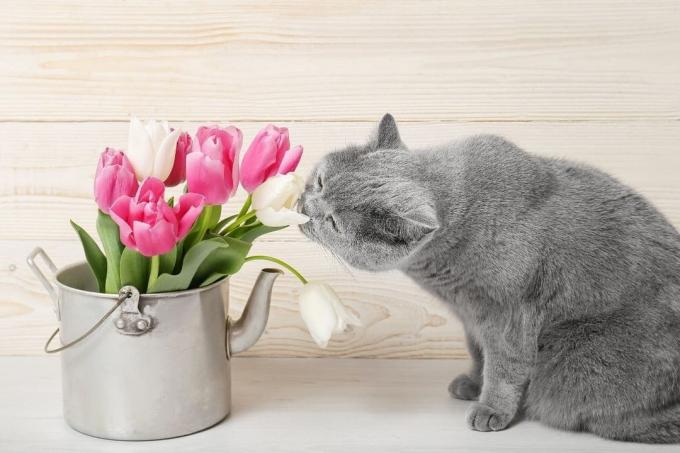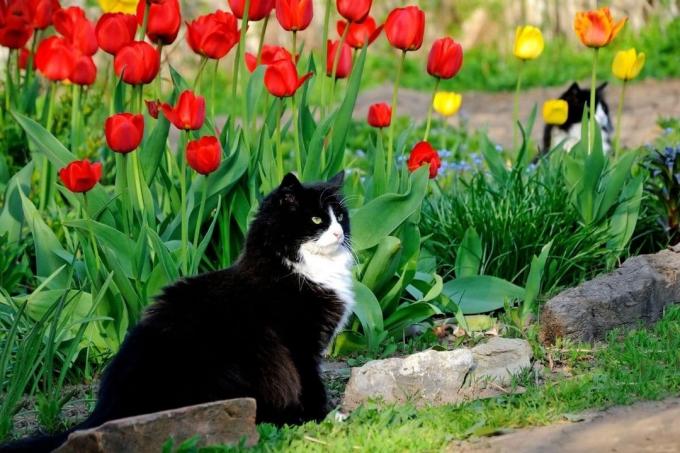
table of contents
- Toxic or not?
- Poisonous plant parts
- Symptoms of poisoning
- Quick help
- Prevent poisoning
- frequently asked Questions
Tulips (Tulipa) are among the first heralds of spring and not only spice up the gray garden, but also as a cut flower the apartment. The latter in particular can be a problem for cat lovers. Are tulips poisonous to cats?
In a nutshell
- Tulips are considered to be highly toxic to cats
- All parts of the plant are affected
- Indoor cats and kittens are particularly at risk
- The risk for free walkers is slightly lower
Toxic or not?
As soon as the cold season is over, be everywhere Flower bulbs offered, u. a. also from tulips. They impress both in the bed and in the vase. But for cat lovers and especially their animals, these colorful heralds of spring are anything but good, because they are highly toxic.

When it comes to cats, you cannot always rely on their instincts, because curiosity and the instinct to play often predominate. Then they like to nibble on plants, unfortunately also poisonous ones. This is partly due to the lack of alternatives to suitable green fodder. Particularly at risk are animals that are kept exclusively in the home and young animals, so-called kittens. A pretty bouquet of tulips can quickly become the cause of poisoning. The situation is different with outdoor animals, they have the opportunity to eat grass and are less interested in tulips.
Poisonous plant parts
All parts of the tulip are poisonous to cats, i.e. leaves, flowers, stems and bulbs, with bulbs and stems being said to be particularly toxic. The poisonous effect is based on the toxin tulipanin. The contained toxins can have an internal as well as external effect. Ingestion in cats is the most common form of poisoning.
Tip: The flower water also has a poisonous effect that should not be underestimated. This can be the water in the flower vase in which the tulips are standing or excess irrigation water in the saucers of potted tulips.
Symptoms of poisoning
If tulips were a victim of the cat, it does not necessarily have to result in poisoning. It is best to take a closer look at the tulips first. If parts of the plants are missing, it is quite likely that the cat has eaten them. There is also an increased risk if your cat just chews part of the plant.
- The smallest amounts of plant material are sufficient for poisoning
- even mere contact with pollen of the tulip
- Poison gets onto the cat's fur
- and by licking or Brushing the body
- triggers violent reactions there
- observe the animal closely if poisoning is suspected
- to identify possible symptoms early on

The first sign of poisoning is usually vomiting. Other symptoms of poisoning can include salivation, diarrhea, dilated pupils, accelerated breathing and problems with coordination (staggering). If the animal suffers from previous diseases of the liver or kidneys, the risk potential is even higher, since the toxins cannot be transported out of the body in the normal way.
Quick help
First of all, you should check the cat's mouth for plant residues and, if there are any, remove it as much as possible. Throwing them away is not a good idea; it is best to take them with you to the vet in a small pouch. He should then be visited as soon as possible. The sooner the animal is presented to a doctor, the faster it can be helped and the better the chances of recovery. Time is particularly important when it comes to large amounts of plant material consumed Factor, because the cat can suffer serious organ damage or, in the worst case, even die.
Prevent poisoning
Poisoning by tulips cannot be completely prevented, but precautionary measures can be taken, especially in the home, to keep the risks as low as possible. The easiest way would of course be to do without tulips and generally all plants that are poisonous for pets in the house and garden. But not everyone can or wants to. Then you should put such plants in a place inaccessible to cats, which is not easy with cats.

Tip: Also, petals falling unnoticed and, as already mentioned, the flower water in the sink pose a great danger.
frequently asked Questions
Eating grass is a natural need for these animals. The open-airers below them eat grass to get the hair swallowed when cleaning out of their bodies. You will then be strangled again and again. The grass acts practically as a natural emetic. The indoor cat does not have this option and makes do with indoor plants, but has no other choice.
To protect the cat and the houseplants, it is advisable to offer her a pot of cat grass. You can buy it in the garden center or sow it yourself. Unfortunately, this doesn't appeal to every cat. Then you can try to plant a piece of sod in a pot of soil and offer it to her. This is particularly suitable for cats who can use a balcony.
No, definitely not. As a result of vomiting, the poison passes through the mucous membranes of the esophagus one more time, which again comes into contact with the toxic substances and worsens the symptoms.


